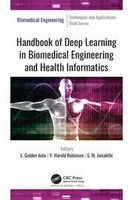Dublin Core
Title
Handbook of Deep Learning in Biomedical Engineering and Health Informatics
Subject
Bioscience, Computer Science, Engineering & Technology
Description
This new volume discusses state-of-the-art deep learning techniques and approaches that can be applied in biomedical systems and health informatics. Deep learning in the biomedical field is an effective method of collecting and analyzing data that can be used for the accurate diagnosis of disease.
This volume delves into a variety of applications, techniques, algorithms, platforms, and tools used in this area, such as image segmentation, classification, registration, and computer-aided analysis. The editors proceed on the principle that accurate diagnosis of disease depends on image acquisition and interpretation. There are many methods to get high resolution radiological images, but we are still lacking in automated image interpretation. Currently deep learning techniques are providing a feasible solution for automatic diagnosis of disease with good accuracy. Analyzing clinical data using deep learning techniques enables clinicians to diagnose diseases at an early stage and treat patients more effectively.
Chapters explore such approaches as deep learning algorithms, convolutional neural networks and recurrent neural network architecture, image stitching techniques, deep RNN architectures, and more. This volume also depicts how deep learning techniques can be applied for medical diagnostics of several specific health scenarios, such as cancer, COVID-19, acute neurocutaneous syndrome, cardiovascular and neuro diseases, skin lesions and skin cancer, etc.
This volume delves into a variety of applications, techniques, algorithms, platforms, and tools used in this area, such as image segmentation, classification, registration, and computer-aided analysis. The editors proceed on the principle that accurate diagnosis of disease depends on image acquisition and interpretation. There are many methods to get high resolution radiological images, but we are still lacking in automated image interpretation. Currently deep learning techniques are providing a feasible solution for automatic diagnosis of disease with good accuracy. Analyzing clinical data using deep learning techniques enables clinicians to diagnose diseases at an early stage and treat patients more effectively.
Chapters explore such approaches as deep learning algorithms, convolutional neural networks and recurrent neural network architecture, image stitching techniques, deep RNN architectures, and more. This volume also depicts how deep learning techniques can be applied for medical diagnostics of several specific health scenarios, such as cancer, COVID-19, acute neurocutaneous syndrome, cardiovascular and neuro diseases, skin lesions and skin cancer, etc.
Creator
Bioscience, Computer Science, Engineering & Technology
Source
https://www.taylorfrancis.com/books/edit/10.1201/9781003144694/handbook-deep-learning-biomedical-engineering-health-informatics-golden-julie-harold-robinson-jaisakthi?_gl=1*1owz9u9*_ga*NjI1MDYwOTAzLjE3MDY1NzQzNDg.*_ga_0HYE8YG0M6*MTcwNzI2OTE2OS4zLjEuMTcwNzI2OTIzNi4wLjAuMA..&_ga=2.162726011.656743298.1707205995-625060903.1706574348
Publisher
Apple Academic Press
Date
2021
Contributor
Amalia TR
Format
PDF
Language
English
Type
Book
Identifier
https://doi.org/10.1201/9781003144694

